

Sponsored by Mick Spacey,
East Anglian Cyclemotor Club,
Norfolk Area
While the immediate post-war years in Italy saw an unprecedented boom in demand for economical transport, the problem with many of the country's motor cycle factories was that they were turned over to military related works in times of national need and, invariably being located within strategic industrial areas, had subsequently been subject to Allied air strikes.
Many of the established motor cycle manufacturers found themselves sifting through the shattered ruins of their bombed out old factories to salvage battered and antique machinery in desperate efforts to return obsolete models to production. On the other hand, Ernesto Frau de Angeli's textile mill at Via J Palma 27 on the outskirts of Milano was not considered of any strategic significance, neither was it located in any target area.
It therefore, not only emerged unscathed from the conflict, but would enviably establish production in spacious modern buildings, extensively furnished with the latest machine tooling, and even equipped with its own extensive and fully covered test track facility!
Looking toward the tremendous transport demand as an alternative to the resumption of weaving fabrics, Ernesto took the decision to produce new Ciclomotori (motor bicycles), and enlisted a number of services to establish the project. Lancia factory engineer Battista Falchetto with other Lancia technicians, the motor cycle and racing driver Piero Taruffi, Ghiro of Turin, and later, Gilera's celebrated designer Piero Remor, are all associated with Motom Italiana SpA designs and development, while the frame concept was credited to 'Pinin' Farina Carozzerria (bodywork).
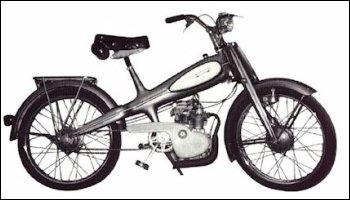
Motomic 12/2
With a press-formed rigid X-frame, integral fuel tank, simple pressed blade girder forks, and pedalling gear set, the appearance of the first 12/2 model was quite bicycle like - even down to a front tyre driven friction dynamo to power the lights!
The engine complemented the originality of its frame design, with 49.78cc from a 40mm bore × 39.8mm 4-stroke OHV, all alloy, 1.4bhp motor with 3-speed gearbox, dry clutch, and wet sump lubrication.
Launched to great acclaim at the Geneva Motor Show in 1947, the Motomic (Atomic Motor) completely eclipsed the only comparable machine in its class at the time, since the Ducati Cucciolo was no more than a mere 2-speed cyclemotor.
With further development, other models followed, introducing magneto flywheel generators to power the lighting, plunger rear suspension, and better hub braking to go with steadily increasing output from subsequent versions of the engine.
The Motom very quickly became one of Italy's top sellers and, by 1950, racing enthusiasts were building hotted-up 11:1 high compression versions fitted with 14mm Dell'orto carburetters, producing 4.5bhp @ 9,000rpm in the very first attempts to establish a 50cc sports category.
A new Motom Delfino (Dolphin) made its début at the 1950 Milan Show, this time a scooter/motor cycle cross with 147cc OHV 4-speed engine, later increased to 163cc for 8bhp.
The fast developing Motom sports 50s were proving particularly robust little machines, and could easily be tuned to exceed 50mph, a most outstanding performance for the early 1950s.
In 1952, the Italian rider Dalmasso averaged 46.5mph over a standing kilometre, simultaneously breaking the 50cc world record by covering the last 500 metres at 58mph.
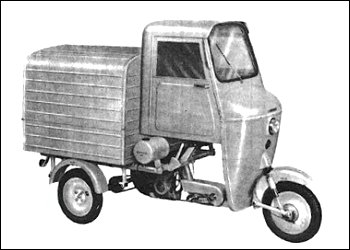
Motom Motocarro
Not everything the company presented, however, was sporty and stylish. 1952 also saw introduction of the 50cc Motocarro, Motom's interpretation of the popular European style of three-wheeled micro-truck based upon a tricycle moped.
An exciting and futuristically crafted new Motom 98TS 4-speed with OHC engine and ducted cooling in a streamlined body was shown on 12th April 1955 at the opening of the Fiera di Milano, and instantly acclaimed as one of the world's most advanced lightweight designs.
Just one year later, sales of the 98TS had boosted Motom up to fifth place in the Italian motor cycle market chart, behind Vespa, Lambretta, Moto-Guzzi and Garelli, but significantly ahead of MV, Gilera and Ducati.
1956 was also the first opportunity for British motor cyclists to see a Motom, as a 49 moped model was displayed at Earls Court, but failed to attract any UK distribution agent.
1957 found the Milan business releasing details of a development 51 model. Slight changes to the bore and stroke, now 40.2mm × 40mm, resulted in displacement of 51cc, which produced 2.5bhp on an 8:1 compression ratio, for a reportedly genuine 40mph top speed. A 51 model de Luxe was also listed with a dual seat and large capacity tank option.
1958 was undoubtedly the sporting pinnacle, where works racing Motom machinery reigned supreme and swept the board at every 50cc competition held in Italy. A Supersport SS version of the 49 moped was introduced with 'clip-on' style handlebars and flyscreen fairing. The 8.5:1 compression for 2.5bhp @ 6,800rpm of the 49SS offered nearly 50mph to claim title to Italy's fastest moped, while its efficient 4-stroke engine could still easily achieve 200mpg economy.
Despite rain at Monza over 3 & 4 April 1958, a world record attempts team with a production SS model resulted in a 100 kilometre speed of 54.10mph, 12 hours at 54.24mph, the standing kilometre raised to 52.23mph - and all at an average fuel consumption of 144mpg!

Towards the end of the 1950s, though, things were starting to get tough for everyone in the motor cycle industry, as increasing social affluence led to increasing sales of cars, and falling demand for bikes.
Further to this, a change to Italian law governing 50cc machines in 1960 introduced speed and weight restrictions in exchange for continued exclusion from driving and vehicle licensing.
Many of Motom's established moped models however, landed outside the new margin, and with falling home market sales, the company had to start looking toward export contracts in order to maintain the business.
1961 was set to be a critical year for Motom. Morray & Co Ltd, St Stephens House, Victoria Embankment, London SW1 were appointed as UK concessionaires, full page advertisements were posted in motor cycle periodicals, with works racing team promotions, and test machines made available for the press.
Models listed by Glass's Index from January '61 were the 48C and 48SS (£103-3s) mopeds of 39mm bore × 40mm stroke, the later being tested by "Centaur" for Cycling & Mopeds in March and, while claimed to achieve 47mph, the feature only recorded 40mph, though it still managed to equal their fastest moped tested at the time.
Also listed as top-billed machine, a model 60S (£104-16s) 51cc sports motor cycle was tested by Bruce Main-Smith for Motor Cycling in February, and two months later by Don Noys for Power & Pedal. Both reported being generally impressed and liking the machine, but the press were invariably complimentary about everything back in those days, or the manufacturers might not let them have anything else - so let's see what we think of it…
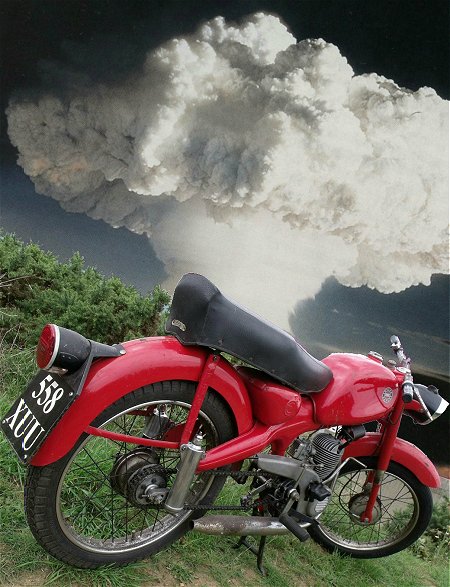
Our test 'Atomic Motor'
Basically a reworking of the 1957 51 model de Luxe, Motom's remodelling equipped the new 60S with a dual seat, though it could be controversial whether this was seriously intended to accommodate two people, and the absence of rear footrests, with no obvious location for even mounting any, suggests it was probably not.
The engine specification: overhead valve 4-stroke with wet sump oiling, bore 40.2mm × stroke 40mm, capacity 51cc, compression ratio 8.2:1, claimed output 2.9bhp @ 7,500rpm. The transmission is laid out through a single plate dry clutch to a 3-speed gearbox; ratios are 11.2, 17.3 and 36.8 to 1.
Though listed alongside other moped models 48C and 48SS, the 60S dispensed with the cable operated hand gear change in favour of a foot operated heel-and-toe rocking lever to the right hand side, with a rear foot brake lever at the left foot. Instead of a pedalling set, footrests each side now hung from the former pedal shaft centre.
Cast in aluminium, the unusual, louvred, one-piece magneto cover and chainguard features a forward operating kick-start lever mounted through the front sprocket axis. The plain rocker cover of the preceding moped models was now replaced by a cosmetic, vertically finned casting, which presents something of a misleading appearance - resembling a typical two-stroke cylinder head, and readily deceiving those unfamiliar with the make that it might be some larger capacity 2-stroke engine.
Motom rather followed the 'lateral thinking' theme, resulting in its own individual and very distinctively odd look. The only other machine that slightly followed similar lines, and made by former Motom employees, was the Pegaso 1955-64.
Not least in Motom's characteristic appearance is the Farina X-frame, its concept with the original rigid chassis being to connect the headstock and rear axle in a single straight span, then crossing the X in another line from stand to saddle. The aesthetic concept became a little diluted by the addition of the plunger suspension units, and further disguised by the frame top mounted fuel tank, toolbox infilling another segment, and again as a dual seat replaced the single saddle on the 60S, but the principle is still there.

After turning on the petrol tap, pretty much the first discovery when attempting to start the bike, is that the kick-start doesn't operate in any conventional manner. Apart from swinging in a forward arc, it appears as if the starter ratchet is not engaging since the lever fails to turn the motor at all - but things are not all they seem...
To engage the kick-start, you need to put the motor into gear!
This appears to be an engineering result of developing the 60S motor cycle version from the earlier moped, which had an extra position beyond third on the hand-change control for pedal starting the engine. This left the top gear engaged, but disconnected the final drive sprocket, allowing the pedals to be used as a kick-starter.
With the obscure 60S motor cycle derivative being much less popular than the moped version, its kick-start arrangement was probably developed with the minimum amount of modification to the gearbox design.
The set-up was little inconvenience on the moped, which after starting, simply required the clutch to be pulled in, and the hand-change moved straight through to 1st in a similar motion to changing from neutral on any conventional moped.
On the motor cycle however, the same cannot be said!
Technically, you have three kick-start ratios to start the engine in, but third is the recommended gear, since first and second gears disadvantage their ratios by turning the engine too much. This means that you have to sit on the bike, rocking it backwards and forwards to work up through the reluctant gearbox, to finally engage top. The downward arc of the kick-start raises a pin against a face-cam around the spindle, and the motor starts, but you also need to remember that you can't release the kick-start or the engine will stall in third, so now pull in the clutch, then release the kick-start, before rocking the bike backwards and forwards again to work back down the reluctant gearbox to find neutral.
New owners will probably go through this ritual just once, if only to satisfy themselves how it actually works ... then spend every other occasion push-starting the bike because it's so much easier.
The 60S surely has the most ridiculous starting procedure of any motor cycle! It's useless!
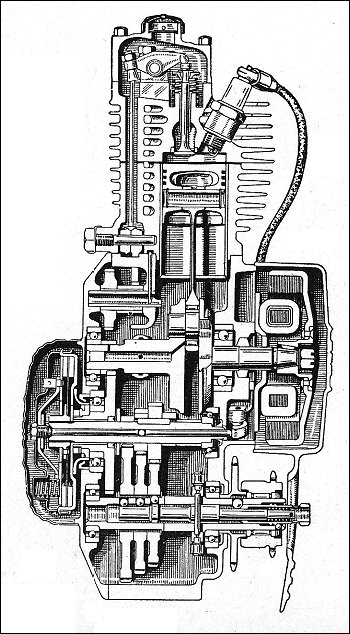
Inside a Motom 48SS engine
Moving right along because we've had more than enough of that nonsense, the exhaust tone is effectively deadened by the silencer baffling and pleasantly unobtrusive. As the motor revs up and down its range though, you're probably going to find yourself more concerned by the tiny rattling tappets and chattering pushrods, nervously wondering if the intricate and delicate workings might spectacularly let go at any moment in classic Italian style.
Heeling back from neutral for first, selection is usually aided by rocking the bike slightly to locate the gear, and despite the small engine capacity, 60S pulls easily away in the low ratio without much need for any delicate clutch control.
Though the engine can be screamed up to 18mph in first, and 27mph in second gear (paced readings), we're changing up well before these maximums since it's not on the racetrack today.
The foot gear-change is a heavy and resistive shift with reluctant engagement, so up-changes require a slow and steady pressure on the lever pad to secure the gear, generally not a good operation to complement the bike's sporting character.
Switching into third gear is rather like dropping into overdrive. The ratio feels rather too high for the 2.9bhp output of the engine, which generally only manages to labour up to around a paced 35-ish on the flat, though the 60mph VDO speedometer was notably indicating only 30mph at this speed!
Headwinds and inclines take their toll on the performance against the high ratio, but light downhill sweeps and tailwinds work much to its advantage, easily allowing the bike to run beyond 40mph (paced - speedometer still reading 5mph slow).
Tucked tight and low on the downhill run with the engine howling like a vengeful banshee, resulted in our fastest paced reading of 47mph, while the speedometer was indicating just 42, still 5mph slow. General cruising on the 60S settles around 30 to 35 in top gear, at which the engine would seem quite content to purr along all day.
The objectionable foot gear-change however, has not yet finished its cursed mission to infuriate the rider. Its wretched final card is played on the downshift from third, as the selector drops you into a false neutral instead of second.
If you try going back up from this again, then it can't seem to find third anymore, so you have to go right back down to first every time, to be able to go back up the box again. It's an infernal irritation, and is probably curable by some fine tuning of the stroke-rod, but seems to require a strip down of the whole selector linkage to enable adjustment, with no surety that any guesswork change may even improve the situation - it could make things worse! A few time-consuming and pointless attempts to correct the adjustment will usually convince the most motivated mechanic as to the futility of such efforts, and that old adage of 'leave well alone' is probably best.
The hopeless gear selection finds this sporty Motom somewhat disadvantaged on cornering by even the humblest of automatic commuter mopeds, as they slip scornfully by on tight turns while you guardedly mutter Latin oaths at the cog box from hell.

The Posa Caolziocorte sprung-mattress, dual seat proved as hard as a board, and no comfortable position could be found when sitting on it. Less like motor cycling, but more in common with martyrdom, within just a few miles it was pretty obvious that the best thing about the saddle would be getting off it as soon as possible!
The riding position is neither natural nor comfortable for any normal sized adult. There's a raised ridge halfway along the seat that ensures the rider can only really sit in the forward position, and typically of a 'sport' bike, the low handlebar mounting puts weight on the arms so you quickly develop aching wrists and hands. The rocking gear pedal doesn't sit in the right position, under neither your heel nor toe, so you have to feel around with your foot when changing up or down; at other times it demands that you turn your right foot out to avoid resting on the toe pedal.
The bike may well have been designed to suit some diminutive Latino, but one size clearly doesn't fit all.
Both brakes proved very effective, general handling, and road holding were good, but not so clever if the surface cuts up rough. The sporting ride might have been influenced by smooth racetrack inspiration, but proved somewhat firm for general road use. Both front forks and rear plungers appeared over-sprung, and afforded little practical suspension to absorb bumps, so a rider is certainly going to become aware of the jolts … this is not a comfort machine!
The centre stand also earned mention in dispatches, for the irritating design means it springs back as soon as you nudge the bike off rest. The stand constantly flicks back up as you're trying to lurch the bike clumsily over centre, at which it settles on the back wheel and ungainly rears its fork set in the air, while the steering flops to full lock - not cool!
Like much of the rest of the bike, the electrical set also follows an unorthodox arrangement. The HT coil is externally mounted beneath the petrol tank and fed from a low-tension coil within the magneto set.
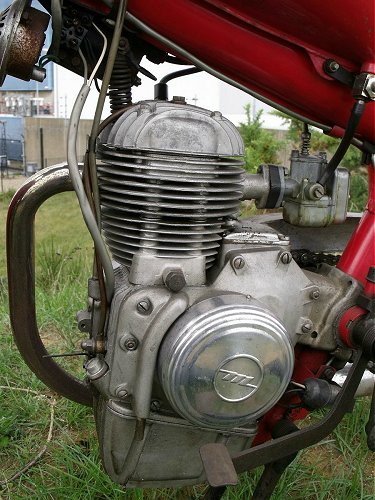
A second coil rated at 30 Watts AC output drives lighting operations that are engaged by a master switch on the headlamp shell, where the 6 Volt × 25/25 Watt headlamp does produce appreciably better illumination than many small capacity contemporaries of the period.
Further to this and for the single function of powering the stop-light, a third coil outputs 15 Watts AC, which is constantly earthed by the closed circuit brake switch in rest position! When the pedal is pressed, the switch goes open circuit, so the power diverts to ground through the stop lamp - all very inverted, but it seems to work just the same!
The higher current in the general circuit means the AC horn also works well, even at low revs, but the secondary beam/dip/horn switch on the handlebars includes no engine kill button, so riders generally resort to stalling-in-gear to stop the motor. Actually there is a kill button, but most folks will probably never find it if they don't know exactly where it is - built into the headlamp shell, and secretly tucked away, right underneath. Why? We don't know!
Considering all the critical points, it may appear as if no-one should like the Motom 60S, but it's so obviously a very smack-you-in-the-face unsubtle example of red and Italian 4-stoke exotica, for which very reason, you tolerate all its shortcomings. Try and tuck into the cycle as best you can fit, listen to the muffled growl from the exhaust as you open the throttle ... and enjoy the moment, because you know this really is something extraordinarily special.
The three works racers at Snetterton circuit's "Battle of the 50s" on 7th May 1961 rather failed to achieve the desired promotional result against the massed ranks of wailing 2-strokes. Despite heading the pack for 30 laps and setting a new lap record of 56.26mph, the lead bike retired with engine failure, a second crashed from sixth place at the Esses, and the sole survivor came home only in third spot.
Back in Italy the new Motom 92 model, a conventionally styled 92cc lightweight commuter motor cycle introduced at the Milan Spring Samples Fair in April 1961, apparently failed to attract buyers as the year went on, and a later 100cc version fared no better.
The Motom models found little appeal to the British public with its entrenched big-bike culture, and following dismal sales figures, the UK market was abandoned in 1963. Morray & Co ceased as UK concessionaires at the ending of imports, and Blacknell Motors Ltd, 87-89 Arkwright Street, Nottingham became listed for distribution of spares.
Though Motom continued to dominate national 50cc racing, its commercial moon was on the wane.
1964 saw, for the first time, a range of machines introduced with French Peugeot 2-stroke engines. Other models followed with German Zündapp motors, and it was a steady slide down the slippery slope until the brand dropped out of the motor cycling market in 1971.
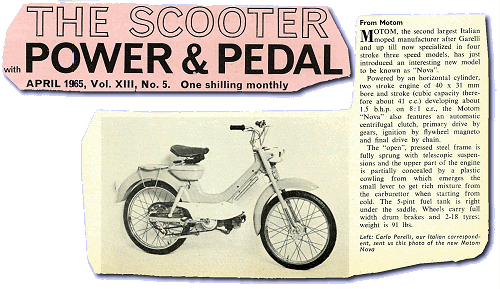
News of the 2-stroke Motom Nova reaches the UK
It's unknown to us at this time what became of Motom over the intervening decades, but the company had certainly also been manufacturing horticultural rotavators for a period.
Motom Italia SpA resurfaced in 2007 with the announcement that its parent group had acquired rights to the Lambretta name and was re-launching the brand with three models of Taiwanese-built scooters. It seems that use of the Lambretta title however, is being contested by other Indian manufacturers who claim to own the brand for marketing a successful range of high street designer clothing.
In the meantime, pictures of a Lambretta 125cc racer have appeared in the media, and the classic Motom logo itself returned in 2009, appearing on a new Model 300 scooter, of unknown origin.
Pending further developments on this unclear situation, we may see more of the seemingly returning Motom brand ... or not?

Next -We've been racking up a series of features on Italian marques but, from the classic 'Big-5' manufacturers, have only visited Moto-Guzzi, then Benelli in the Motobi feature. That leaves Bianchi, Garelli, and Gilera, so maybe it's one of these next ... so who made a cyclemotor. OK, so that just narrows it down to two!
To be honest, at this time we don't actually have any firm article even started, though there are three possible options bubbling in the pot. If we manage to get it completed, then Stingers would probably be the favourite, so you might like to dig out your bug repellent spray in case you get bitten.
[Text and photos © 2010 M Daniels. Period documents from IceniCAM Information Service.]
The Motom article was a fairly fresh feature, mostly drafted from a research pack among the Cyprus 2010 batch. Out of the Extraordinary was initially expected to be run as a support feature, but the research uncovered so much interesting historical detail that the text file grew disproportionately, and we ended up with a main feature instead!
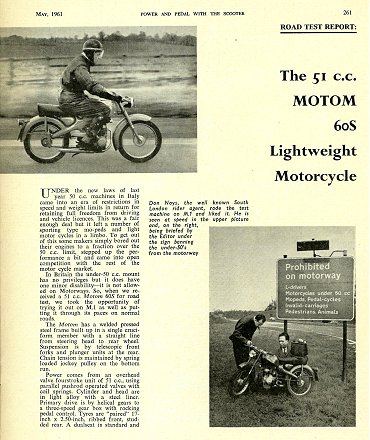
The 51cc
engine in the 60S made it legal
to use on Britain's newly-opened motorways -
so Power & Pedal did just that!
We wondered how many people might have fallen for our misleading clue from Green Machine in the last edition and wrongly guessed that the next main feature might be the Cucciolo? An easy presumption to make, though the often over-rated 4-stroke Ducati cyclemotor became widely familiar in Britain, it could never hold a candle to Motom's virtually unknown but superior construction, performance, and extra internal ratio.
The Motom was a particularly important machine, since 50cc racing was primarily established around this make, and our rare example Model 60S was particularly interesting, as one of the few officially imported machines that managed to sell in Britain. Being the top listed Motom model in the UK, the 60S seemed to have been favoured for test by the motor cycling press of the time, so a most ideal machine to cover in our own presentation.
The featured bike had a particularly interesting story attached to it too … the tale goes that it was purchased by a West Country motor dealer, who never registered the bike, just riding it about occasionally on trade plates! Sometime later it seemed to have passed on to others, who just took it to shows, but again never registered or really rode it, until 2009 when we picked it up, sorted it out, and finally dealt with a proper registration.
The history seemed fairly plausible, since there had clearly never been any number plates fitted, the tyres were still the original Pirellis, the footrest rubbers perfect, and not a screw or nut showing any evidence of ever being disturbed. Though only having an apparently genuine 562 miles on the clock, there had obviously been a number of issues however ... a snag in the chain had buckled some links, damaged the crankcase and alloy chainguard, all of which needed some careful repairs, and a rear suspension unit had somehow become broken, so more alloy welding. The bike had apparently fallen over at some time, landing on the gear-change lever and busting the delicate iron castings of the selector mechanism - ouch! The rear light wiring insulators had contacted the back tyre, worn through and shorted all the lighting and brake light circuits - which someone had cleverly resolved by simply disconnecting everything! Then, finally, it seemed to have stopped running when the mag set condensated and furred up. Not so many easy-fix problems among this catalogue of disaster, though it all seems worth it when you finally get to ride the bike ... but if all this happened in just 562 miles, you do wonder how long it may hold together before the next catastrophe?
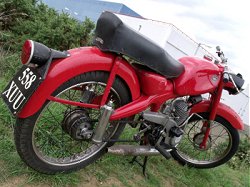
That's Sizewell power station
in the background...
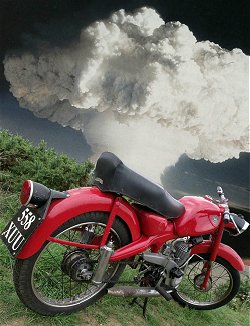
...and now it's gone!
The perception that these old Italian bikes went well, but broke pretty quickly, does rather seem underlined once again.
Launched at the Geneva Motor Show in 1947, the 'Motomic' (Atomic Motor) led to a subtly associated nuclear presentation. How many people spotted the photoshoot background was taken outside the nuclear power station at Sizewell? The grey, square 'A' building housed two old Magnox 1,000MW reactors, while the big blue unit with the white ball on top is the new PWR 'B' reactor (and, yes, we were 'interviewed' by the security police about what the photographs were about - the lengths we sometimes go for these photoshoots!)
And for those amused by the atomic mushroom cloud in the background of our Motom 'cover' picture, no, we didn't blow up Sizewell for this shot, it was another of Andrew's digital make-overs.
There was another digital reworking to enhance another picture of the Sizewell 'B' PWR dome against the background sky, that was supposed to be used among the magazine pics - then halfway through the printing it was noticed that a completely different picture had been inadvertently included instead! Too late! Never mind, it'll caught up in the Directors Cut version for the website Articles section.
Though acquisition and reconstruction of the 60S, then detailed research and drafting of the text involved some most considerable input, direct production costs were actually quite minimal ... barely £10 of fuel to Sizewell and back, and thanks to Mick Spacey of EACC Norfolk, for sponsoring the feature.
We're pretty sure the article now presents the most comprehensive Motom reference freely available in the public domain, so another worthwhile drop in the pool of general knowledge.
Motom made the fourth consecutive feature in our little Italian sequence, which has been running since the first issue of 2010. Could this series continue, or may the prospect of more difficult research drive us completely mad?
Well, maybe just one more...